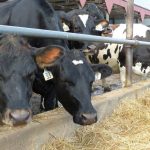
While the virus known as “Bird Flu” has recently been found on commercial duck farms in LaGrange and Elkhart counties in northern Indiana, the detection of the virus will also have an impact on nearby dairy producers.
“While this is early in the cycle for Indiana, this isn’t 100 percent unexpected,” says Denise Derrer Spears, Communications Director with the Indiana State Board of Animal Health (BOAH).
On Thursday evening, state health officials announced that highly pathogenic avian influenza (HPAI) was found on a commercial duck farm in LaGrange County with a flock size of 2,600 birds. A little more than 24 hours later, officials said the virus had also been found on a commercial meat duck facility in nearly Elkhart County impacting 3,500 birds.
Spears tells Hoosier Ag Today that the virus is believed to be picking back up and spreading through migratory birds.
“Working with our wildlife partners over at the Indiana Department of Natural Resources (DNR), there have been positive cases found in wild birds in Indiana already this year, particularly in the southern part of the state,” she says. “We know other states have been impacted on their commercial poultry sector just within the last couple of weeks.”
Since LaGrange and Elkhart counties are home to many dairy farms, she says state health officials also plan to monitor the dairy cattle in the area to ensure that they don’t end up getting the bovine version of the virus.
“While we’ve not found out on any dairy farms in Indiana with all the surveillance that we’ve been doing, LaGrange is our top county as far as the number of dairy farms—not necessary number of cows, because you have a lot of small family farms in that area,” says Spears. “Those that land in that control area are going to need to be sampled as well, so that’s another step we’re going to have to take is to go out and collect milk samples and make sure that has been in any spread within the community.”
She says the goal is to continue to keep the virus from impacting Indiana’s dairy producers, as milk samples will be collected near poultry farms that have had positive cases of HPAI.
“Our message to all dairy farms, regardless of where they are, is to keep their biosecurity high and make sure they’re controlling wild bird populations and places where they can nest,” she says. You don’t want any kind of pests running through that could carry the virus. “You also want to make sure, if you’re buying new stock—if you have new heifers and new cows coming in—get them tested, especially if they’re coming from outside the state,” says Spears.
According to USDA, 18 states—including Ohio and Michigan—have had at least one case of HPAI in dairy cattle.
CLICK BELOW for Hoosier Ag Today’s radio news report:









